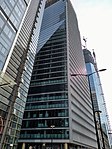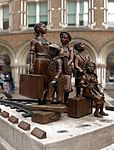White Hart, Bishopsgate
Former pubs in LondonLondon stubsPubs in the City of London

The White Hart is a former pub at 121 Bishopsgate, London. The librarian at the Bishopsgate Institute, Charles Goss, wrote a history of the White Hart in 1930, and believed that it dated back to 1246. Samuel Nixon (sculptor) had his workshop at The White Hart (1838-1854). It certainly existed as The White Hart in 1377. However, it was rebuilt in 1480 and 1829. It closed in 2014, and its facade was integrated into a nine-storey office block.
Excerpt from the Wikipedia article White Hart, Bishopsgate (License: CC BY-SA 3.0, Authors, Images).White Hart, Bishopsgate
Bishopsgate, City of London
Geographical coordinates (GPS) Address Nearby Places Show on map
Geographical coordinates (GPS)
| Latitude | Longitude |
|---|---|
| N 51.5168 ° | E -0.0811 ° |
Address
Pan Pacific
Bishopsgate 150
EC2M 4AF City of London
England, United Kingdom
Open on Google Maps










